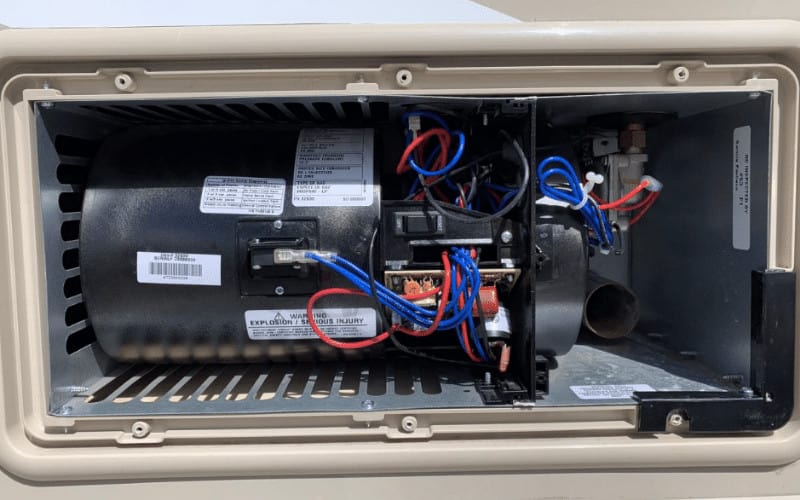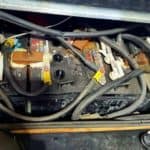The amount of propane your RV furnace uses depends on its age and size. Older models are less efficient. And typically, the larger the furnace, the more propane you’ll need to power it.
So knowing “burn” rate of your RV propane heater is import to get the estimates how long a tank of propane will last with a given propane furnace.
An average-sized RV furnace rated at 30,000 BTUs, and one gallon of propane has a burn rate of approximately 91,547 BTUs per hour. That means you can run an RV propane heater for 3 continuous hours with a gallon of propane.
But no one will run their furnace for 3 hours continuously, so what are the real-life calculations?
And what are BTUs? How do you find out the BTU rating for your rig’s furnace? Are there ways to maximize your propane use efficiency (and thus save money)?
Keep reading to how much propane your RV furnaces of different sizes use per hour / day / month when running at full capacity, so you can get a jump-start on preparing for your propane needs as the cold months quickly approach!
How to Calculate the Propane Usage for Your RV Furnace
The first step in learning how much propane your RV furnace uses is finding the furnace’s BTU rating.
BTU stands for British thermal unit and is a standard unit for measuring heat.
The higher the BTU rating of the furnace, the more heat it produces. As a result, the higher the BTU rating, the more propane will be used.
The size of the RV determines the optimum BTU level required to heat it. A good guiding principle is to estimate 1,000 BTUs per foot of your vehicle.
So, if your RV is 40 feet, you’ll need a 40,000 BTU furnace to heat it properly.
20,000, 30,000, and 40,000 BTUs are common sizes for RV furnaces. The chart below shows how much propane these furnaces would use during an hour of continuous use.
Propane Use Per Hour Of Continuous Furnace Use
BTU Rating | Gallons of Propane / Hour of Continuous Use | Number of Hours a Gallon Would Last |
20,000 | ¼ gallon/hour | 4 hours |
30,000 | ⅓ gallon/hour | 3 hours |
40,000 | ½ gallon/hour | 2 ½ hours |
To find out the BTU rating of your rig’s furnace, you can look in the owner’s manual for your RV, do an internet search for your RV’s specs, or contact the manufacturer.
What Size Is Your Propane Tank?
Another factor to consider is the size of your propane tank(s). Many RVers use 20, 30, or 40-pound tanks, depending on furnace size.
A 20-pound propane tank carries around 4.7 gallons, whereas a 30-pound propane tank holds 7 gallons. The 40-pound tank contains around 9.4 gallons.
Once you have learned your furnace size, you should consider what size propane tank to use.
How To Calculate Your Furnace’s Propane Use
Let’s get into some real-life calculations of how much propane an RV furnace uses.
We’ll consider the estimated calculations for a 30,000 BTU furnace. Again, one gallon of propane has a burn rate of close to 92,000 BTUs per hour.
That gallon will run out after about 3 hours (184 minutes) of continuous use if your furnace has a BTU rating of 30,000.
But you’re not going to run your furnace non-stop for 3 hours. You would set your thermostat to a comfortable temperature, and your furnace would switch on for a few minutes at a time to maintain that temperature.
So, let’s say your furnace runs 4 times each hour for 3 minutes each time, 12 minutes total per hour. You can expect one gallon of propane to last for a bit more than 15 hours:
184 minutes / 12 minutes per hour = 15.3 hours.
Now, you happen to have two 20-pound propane tanks all set to use. That means you have 9.4 gallons of propane at your disposal.
And each gallon gives you about 15 hours of heat. So that gives you 141 hours or almost 6 days of propane heating:
9.4 gallons of propane x 15 hours = 141 hours
141 hours = 5.87 days.
(These calculations are only taking into account the furnace as a propane-operated system in your RV.
Be sure to make adjustments if you are using propane for other appliances, such as the refrigerator or stove.)
Does Your RV Have More Than One Heating Unit?
If your RV is over 35 feet, it may have more than one heating unit installed.
No need to worry about increased propane use, however; both units are not likely to be running at the same time.
Because they cover different areas of the vehicle, only one will most likely be in use at a time.
How Can You Increase Your RV Furnace Efficiency (And Save Money On Propane)?
So, you definitely want to avoid running out of propane and enduring a cold, heatless night like I…er, I mean, the person in the outset did.
Is stocking up on tons of propane the answer?
No. Hauling excessive tanks of propane on your RV trips would be impractical, costly, and wasteful.
Let’s take a look at some tips on how to increase the efficiency of your RV’s furnace and save on propane costs:
1. Make Sure Your RV Is Properly Insulated
Even the most top-of-the-line RV is significantly less insulated than other types of housing.
As a result, once your furnace shuts off after reaching the set temp, cold air can easily seep back into your camper, causing the furnace to switch right back on again.
Fortunately, there are several steps you can take to keep the heat inside where you need it and the propane use minimized:
Seal up any air leaks. Check around windows, doors, and slideouts to find out if there are any openings where air is seeping in. You can seal these leaks using a rubber-based sealant or spray foam.
Another option is to get a fabric draft stopper snake to place at the bottom of your RV doors and a window insulation kit to keep windows sealed to the max.
Use insulated thermal curtains. Thermal curtains can help improve insulation by confining cold air between the window and the curtain, thus preventing it from entering the camper. You can purchase insulated window coverings or try some DIY options.
Keeping the warm air in and the cold air out will help you use your furnace (and your propane) less.
Use RV skirting. RV skirting is often used to keep the plumbing systems from freezing by stopping air from getting to the underbelly of the rig.
But skirting can also help keep the inside warm by trapping in warm air that might escape from the floor of the camper.
This will keep the inside of your RV warmer and help you save on propane.
2. Be Sure Your Furnace Is Clean And In Good Repair
To keep your RV furnace running at its best, be sure to keep routine maintenance in mind. A good practice would be to have it professionally serviced at least once a year.
Here are some things you can do to be sure your furnace is operating efficiently:
3. Be Mindful Of Your Thermostat Setting
Do you and your family agree on what constitutes a comfortable temperature? If you’re on the side of keeping the thermostat lower, here’s a good argument for your case: Lowering the temperature on the thermostat is an excellent way to decrease propane use.
Here’s how to do it and still stay warm and toasty in your camper:
Are There Any Alternatives To Propane Heating?
Absolutely! Using an alternative to the RV furnace to heat your rig is an excellent way to conserve propane.
Using an electric heat source can be ideal, especially if you are at a campground with a full electric hookup included. Read on to see what the options are:
Use a space heater. Electric space heaters are convenient and portable, perfect options to supplement the heating needs of your camper.
Many RVers use one in the living area during the day then move it into the bedroom at night.
Look for a model with safety features such as automatic shut-off in case the appliance gets tipped over.
There are also space heaters with convenience features such as remote control, oscillation, and adjustable speed settings. Enjoy cozy warmth in your RV while keeping your propane!
Invest in an electric blanket. Another heat source that can make your nights warmer without draining your propane is an electric blanket.

There are even some options available that don’t require an electric hookup. You may be able to find a heated blanket that is battery-powered or that connects to your vehicle’s cigarette lighter.
As you would when shopping for a space heater, research your options carefully and avoid any models with potential safety issues.
Consider using an RV fireplace. Some RVs come with fireplaces pre-installed.
Along with adding ambiance to the room, these electric fireplaces can provide heat and help you free up your furnace.
If your RV does not come with a fireplace, you can choose from many compact options that are ready to install.
Propane Safety
Keep safety at the forefront! Make sure all smoke, propane, and carbon monoxide detectors are in good working order as an extra precaution.
Remove all heat sources and evacuate the RV immediately if you smell propane.
Let’s Stay Warm!
Although the temperature may be falling, there is still plenty of camping fun to be had! Just be sure to learn your propane and insulation needs so you won’t have any bitterly cold nights ahead.
Keep your furnace on a low setting when you’re away and at night. Insulate your RV as much as possible.
Use an electric space heater or other heat sources to supplement your furnace.
With a little forethought and preparation, you should be able to stretch your propane and stay warm while RVing in cold weather!
Handing the propane tank over to you! Do you have any tips for conserving propane and staying warm while RVing in cold weather? Leave us your tips in the comments below!







1 Comment
Name
9 months agoWith a ducted blowing system your battery may run out off grid before your propane does.